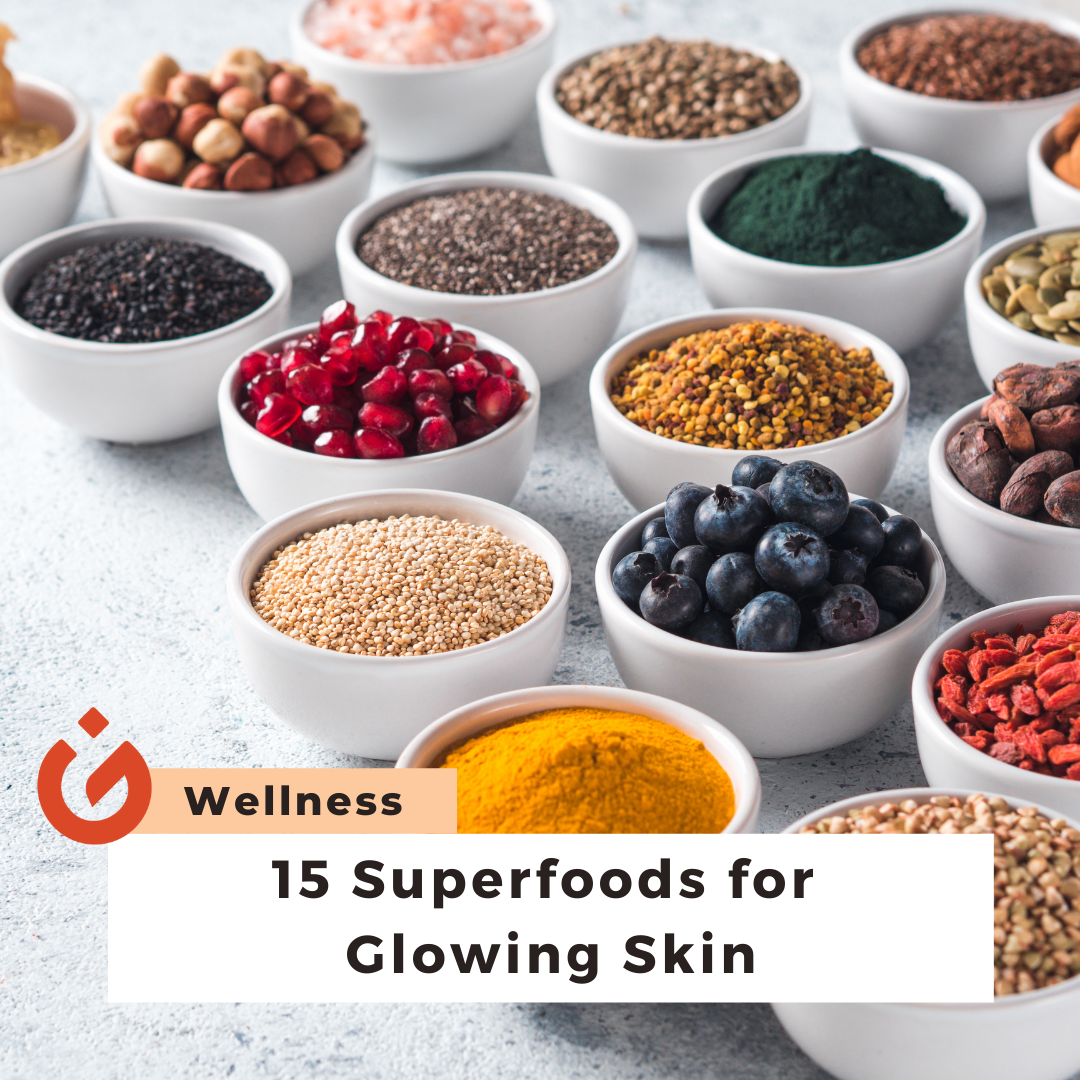
15 Superfoods for Glowing Skin
You’ve heard the saying you are what you eat, but when it comes to your skin, there’s one thing we know for sure: What you eat can have a direct impact on your complexion.
So, take note, because this shopping list will not only fuel a healthy body and mind, but also help solve your biggest skin concerns and lead you to your most glowing look yet.
No matter what your skin is like…
Tomatoes: One of the best sources of lycopene, an anti-aging antioxidant that may also help prevent heart disease. Some research shows that lycopene is more easily absorbed by your body when it’s cooked, so get cooking.
Ginger: Ginger is best known for its antioxidant and anti-inflammatory properties that are found in the root of the spice, not to mention studies show ginger can have a soothing effect on skin, so don’t be surprised when you see it on facial menus, too.
Chia seeds: A great smoothie ingredient, or for sprinkling over oats in the morning. Chia seeds are one of the richest sources of omega-3 fatty acids. Omega-3 fatty acids help provide building blocks for healthy skin cell function and new collagen production to keep the skin foundation strong and wrinkle free.
If you have acne.
Oatmeal: Swap sugary cereal for a bowl of plain oats and your skin will thank you. This food is low on the glycemic index, a scale that rates foods containing carbohydrates according to how much each food increases blood sugar (high-glycemic foods cause a fast, drastic spike and subsequent crash, whereas low-glycemic options provide a slow, steady increase and decline). “
Foods with a low glycemic index are better because starchy foods [that are high-glycemic] increase blood sugar, promote inflammation, and have been shown to be associated with acne breakouts.
Miso: We could be boring and tell you to have yoghurt because it has a lot of probiotics, and probiotics are great for your skin, digestive system, and bloat control. But you’ve heard that a billion times before, and it’s not exactly helpful if you’re lactose intolerant. Instead, try miso, which has all of the same gut-friendly bugs. Did someone say sushi with miso soup for lunch? Count us in.
Artichokes: Artichokes contain the flavonoid silymarin, an antioxidant that can protect the liver and help clear blemish-prone skin, and since it’s often paired with spinach, another acne-fighting food (see below), we say it’s okay to enjoy that famous football dip every once in a while.
If you have oily skin.
Sweet potatoes: There’s no reason to go carb-free just because you’re after perfect skin. Sweet potatoes are full of vitamin A, and vitamin A derivatives have been shown to help reduce oil production in the skin, and are used to treat acne.
Cinnamon: Perhaps your skin always looks great in the fall and winter seasons isn’t the soft glow of your Christmas lights, but instead it’s all the cinnamon in the season’s goodies. The basic spice is great for stimulating circulation and blood flow, bringing oxygen and nutrients directly to the skin. Plus, some studies have shown that cinnamon could help to stabilize and balance blood sugar levels, which is important, when a diet heavy in sugar and refined carbs (ahem, holiday cookies) can stimulate oil production. She suggests adding a dash of the spice to your coffee or tea to start your day off right, or blending some into a morning smoothie.
If you have dry skin.
Avocados: There’s a reason guac is extra! High levels of healthy oils and vitamin E, both of which are found in avocados, provide the building blocks for healthy skin cell function.
Sardines: Don’t rule out canned fish. Sardines are an excellent source of vitamin B12 and selenium, B12 plays a major role in skin cell reproduction, and when you’re lacking the vitamin, it often causes dry, patchy skin. So, pass me the can opener.
If you have dark under-eye circles.
Spinach: Leafy greens like spinach, kale, and collard greens, along with broccoli and Brussels sprouts, are rich in vitamin K, a powerhouse nutrient when it comes to improving blood circulation and coagulation. Spinach is also loaded with zinc, which has been shown to help reduce inflammation and help prevent acne breakouts.
If you have dark spots.
Citrus fruits: Dark spots are caused by extra pigment production due to UV light exposure, Topical antioxidants like vitamin C have been shown to help calm inflammation, brighten dark spots, and even your skin complexion. Eating citrus may also help, he notes, so foods like oranges, tangerines, and grapefruits should be your top snacks.
Bell peppers: Another food high in vitamin C, these veggies can help smooth out your skin and lighten the appearance of any dark spots caused by the overproduction of pigmentation. Not a big fan of peppers? Broccoli, cauliflower, and berries are also high on the vitamin C list and make for a less-spicy snack.
If you have a dull complexion.
Paprika: If your skin is looking a little drab in those Insta-pics, it’s time to spice things up in the kitchen—literally. Paprika provides a great source of antioxidants, including vitamin C and E, and beneficial carotenoids like zeaxanthin. Try sprinkling it onto sweet potatoes with olive oil before roasting, or use it as a rub on chicken breast with garlic powder and cayenne.
Turmeric: All the top chefs are cooking with this trendy spice (and beauty gurus are DIY masking with it), and for good reason. It contains curcumin, an antioxidant that combats free radicals that are seriously dulling your skin. It also promotes collagen synthesis, and when used topically it can help renew the skin by acting as a stimulator for skin elasticity and firmness, in turn fighting any wrinkles and fine lines. Enjoy it sprinkled in an egg scramble or frittata, or blend it straight into a smoothie—we promise you won’t even notice it!






